For us in the States, 1986 was the first time we could zip down the road on a Gixxer, so this year is something of an unofficial 25th anniversary for the 750 in America. Thankfully, we at least have an upgraded and lighter weight GSX-R750 in 2011 to celebrate with – even if we’re the only ones partying.
The 2011 GSX-R750: The Sixxer’s Burlier Twin Brother
Suzuki revised the 750 and 600 at the same time, with the 750 getting virtually all the goodies with which the 600 was endowed. Full details on the Gixxer’s 2011 changes can be seen in our preview article.
The bigger Gixxer’s engine, like the 600’s, now has pentagonal ventilation holes to help reduce power losses from crankcase pressure. Additional shared updates include revised cam profiles, hardened connecting rods, improved crank pin bearing and new starter motor. Otherwise, the 750’s engine is mostly the same as the previous model.
Key but subtle indicators you’re looking at a GSX-R750 are black wheels (white on the 600), slightly less busy decal scheme on the Blue/White color, and the number 750 on the tail section. Beyond that, good luck picking out a 750 in a crowd of GSX-R600s.
It’s been a few years since I last rode a GSX-R750, but blitzing through the first lap on the Barber Motorsports Park road course, the bigger Gixxer’s extra displacement made it clear I was no longer on the 600. With a claimed 148 hp and 20 fewer pounds to hustle around this year, the 750’s meaty mid-range is especially appreciable when digging out of slower-speed corners.
In the GSX-R600 review I said the supersport’s newfound mid-range torque allows a rider to sometimes run one gear higher than he or she might normally when exiting turns. The 750’s extra grunt leaves little question as to whether or not it can pull the higher gear on corner exit.
“Big whoop,” you say, “who could tell the difference?”
You’re right. You probably couldn’t sense the narrow gap in wet weights – except when the 750’s mill is revving and spinning. Through the magic of physics the 750’s unfortunate but nevertheless necessary extra pounds are noticeably magnified, as they’re not static pounds, but instead are manifest as rotating mass of the crank.
Along with the 750’s additional rotating weight that compels it to keep moving forward in a straight line, its BPF (Big Piston Fork) also has firmer compression damping settings than what the 600’s BPF uses. This heavier, firmer, combination means the 750 doesn’t necessarily flick in to turns with the same feathery steering compliance found in the GSX-R600.
The 750’s handling, despite the heavier steering effort, is still a strong weapon in this bike’s arsenal. Overall chassis stability and suspension feedback on the 750 are also are quite good, just as on the 600.
Suzuki’s rider-selectable engine mapping (S-DMS) is also updated on the 750, now consisting of just A and B modes. Just as Suzuki widened the gap in power between the two settings on the supersport 600, with B mode a tick softer than C mode in the previous S-DMS, the same principle was applied to the 2011 750.
However, the new 750’s power delivery in B mode is considerably softer than what C mode delivered on the previous model according to power graph overlays provided by Suzuki. Regardless, the new 750’s B mode is likely still more powerful, if even by a few horsepower, when compared to 600’s full power setting.
Conclusion
The 750cc supersport class is held captive by the Gixxer, as no other manufacturer produces a sporting, race-derived machine with an inline-Four in this displacement. The Gixxer 750 remains a lonely king.
Now that I’ve ridden both the 600 and 750 ‘round the racetrack, the 600 better suits my tastes for track time – primarily for its lighter-effort steering.
However, for the rider that desires a top-performing sportbike for everyday street use, with the occasional trackday here and there, the extra horsepower and mid-range pulling power the 750 offers are enticing.
The 2011 GSX-R750: The Sixxer’s Burlier Twin Brother
Suzuki revised the 750 and 600 at the same time, with the 750 getting virtually all the goodies with which the 600 was endowed. Full details on the Gixxer’s 2011 changes can be seen in our preview article.
The bigger Gixxer’s engine, like the 600’s, now has pentagonal ventilation holes to help reduce power losses from crankcase pressure. Additional shared updates include revised cam profiles, hardened connecting rods, improved crank pin bearing and new starter motor. Otherwise, the 750’s engine is mostly the same as the previous model.
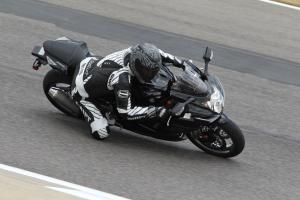 |
| Top 2013 Suzuki GSX-R750 Review |
Like any Gixxer, the 750 is at home on a racetrack, and its generous midrange torque is an asset for everyday use on the street.
Visually, it’s difficult to discern between a 600 and 750.Key but subtle indicators you’re looking at a GSX-R750 are black wheels (white on the 600), slightly less busy decal scheme on the Blue/White color, and the number 750 on the tail section. Beyond that, good luck picking out a 750 in a crowd of GSX-R600s.
It’s been a few years since I last rode a GSX-R750, but blitzing through the first lap on the Barber Motorsports Park road course, the bigger Gixxer’s extra displacement made it clear I was no longer on the 600. With a claimed 148 hp and 20 fewer pounds to hustle around this year, the 750’s meaty mid-range is especially appreciable when digging out of slower-speed corners.
In the GSX-R600 review I said the supersport’s newfound mid-range torque allows a rider to sometimes run one gear higher than he or she might normally when exiting turns. The 750’s extra grunt leaves little question as to whether or not it can pull the higher gear on corner exit.
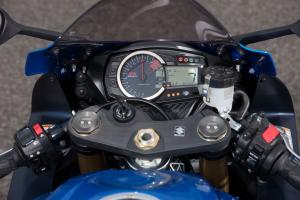 |
| Top 2013 Suzuki GSX-R750 Review |
Like the GSX-R600, the 750 also received a new instrument package courtesy of the GSX-R1000. The GSX-R750 hits redline approximately 1,000 rpm sooner than the 600, but the 750 boasts an additional 25 horsepower. Bonus!
Lots of folks subscribe to the mantra that there’s no replacement for displacement. While there’s some credence to that philosophy, the Gixxer 750 does have something of a hidden liability within its engine – especially notable when ridden back-to-back against the GSX-R600. Although the 750’s curb weight is a scant 7.0 pounds more than the 600’s 412-pound ready-to-ride weight, the 750’s few extra pounds are found mostly in its engine, according to Suzuki staff.“Big whoop,” you say, “who could tell the difference?”
You’re right. You probably couldn’t sense the narrow gap in wet weights – except when the 750’s mill is revving and spinning. Through the magic of physics the 750’s unfortunate but nevertheless necessary extra pounds are noticeably magnified, as they’re not static pounds, but instead are manifest as rotating mass of the crank.
Along with the 750’s additional rotating weight that compels it to keep moving forward in a straight line, its BPF (Big Piston Fork) also has firmer compression damping settings than what the 600’s BPF uses. This heavier, firmer, combination means the 750 doesn’t necessarily flick in to turns with the same feathery steering compliance found in the GSX-R600.
The 750’s handling, despite the heavier steering effort, is still a strong weapon in this bike’s arsenal. Overall chassis stability and suspension feedback on the 750 are also are quite good, just as on the 600.
An alternate to the traditional Suzuki GSX-R Blue and White is this all-black color scheme. The 750 received the same external updates the GSX-R600 was graced with, including lighter bodywork, lighter weight stacked headlamp, Showa Big Piston Fork and Brembo radial-mount monobloc calipers. |
Suzuki’s rider-selectable engine mapping (S-DMS) is also updated on the 750, now consisting of just A and B modes. Just as Suzuki widened the gap in power between the two settings on the supersport 600, with B mode a tick softer than C mode in the previous S-DMS, the same principle was applied to the 2011 750.
However, the new 750’s power delivery in B mode is considerably softer than what C mode delivered on the previous model according to power graph overlays provided by Suzuki. Regardless, the new 750’s B mode is likely still more powerful, if even by a few horsepower, when compared to 600’s full power setting.
Conclusion
The 750cc supersport class is held captive by the Gixxer, as no other manufacturer produces a sporting, race-derived machine with an inline-Four in this displacement. The Gixxer 750 remains a lonely king.
Now that I’ve ridden both the 600 and 750 ‘round the racetrack, the 600 better suits my tastes for track time – primarily for its lighter-effort steering.
While the GSX-R750 remains in a class of its own, and without a premiere race series in which to compete, Suzuki continues to keep the Gixxer 750 up-to-date. Among modern sportbikes, this motorcycle represents one of heck of a value. |
However, for the rider that desires a top-performing sportbike for everyday street use, with the occasional trackday here and there, the extra horsepower and mid-range pulling power the 750 offers are enticing.

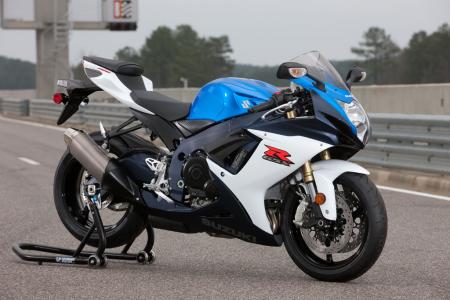
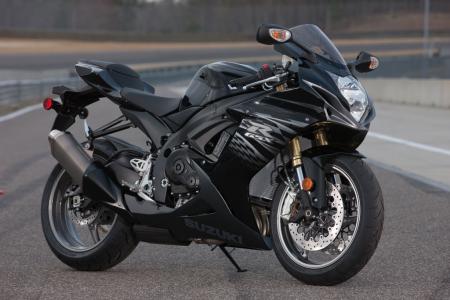
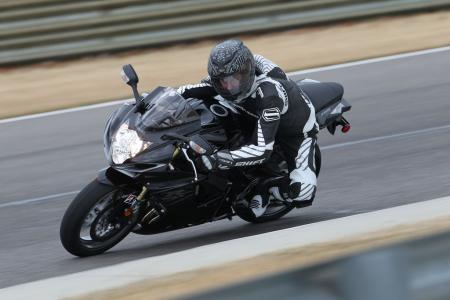
No comments:
Post a Comment